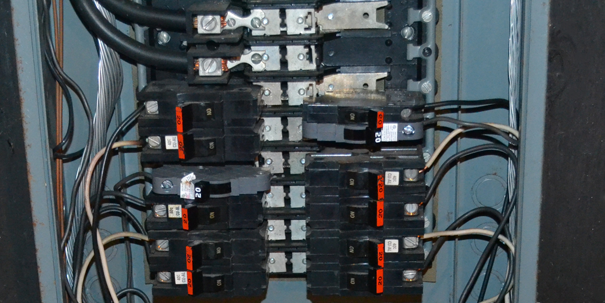The 2011 story of two terrible house fires sent readers (and those of us who researched, wrote and edited the story) straight to their electrical boxes to make sure they weren’t housing a Stab-Lok breaker panel, the source of serious danger.

Houses and businesses built between 1950 and 1985 might still have these Federal Pacific Electric Stab-Lok breaker panels, which are a fire hazard. The company is out of business, but many of these panels still exist in basements and garages. (Hartford Steam Broiler)
Since Karen Clardy announced retirement from her longtime post at Lake Highlands High School, we’ve been thinking about the times she’s made news. No, not for her detective work on the muffin case, another time. The time her house burned down.
It was five years ago, and bad day altogether for the Clardy clan (their dog had died the same day their home burned), but there was a lesson to be learned, not only by them, but by everyone who heard their story. And that lesson, for those of us who live in neighborhood homes built in the 1960s, ’70s and ’80, it bears repeating.
Check your electrical breaker.
The source of the Clardy’s fire was, according to Dallas Fire-Rescue reports, was the electrical panel, a Federal Pacific Electric Stab-Lok, a model one can reasonably assume still is installed in some area homes. Replacing a breaker isn’t cheap, but, for the April 2011 story we spoke with one resident who desperately wishes he’d forked out the $2,000-plus to do so.
“Lake Highlands resident Keith Graham knew about the potential dangers of his FPE panel and wishes he hadn’t waited to replace his. Just after midnight on May 16, 2009, he and his wife, Kathleen, awakened to their “dogs barking like crazy.” They thought someone was breaking in. Keith jumped into action. “In the seconds between getting up and reaching the garage, I noticed the lights were out. I wondered, ‘Did they turn off our electricity?’”He opened the garage door to an inferno that had already engulfed the family car. He yelled at his wife to get their son, Jason, and get out. Smoke filled the house. He grabbed his phone, dialed 911 and ran out the front door hollering for his wife, but no answer. He ran back inside.”
Keith’s wife and first responders found Keith wandering around the neighborhood in the dark, delirious from severe smoke inhalation and shock.
The next day, the fire investigators told the Grahams that the blaze started in the electric panel. “I knew it was a bad panel,” he said at the time. The family was preparing to embark on a remodeling project and Keith, who runs a Lake Highlands-based air conditioning company with his brother, Kelly, had already purchased a replacement. He just hadn’t gotten around to installing it yet. “I lost everything in that fire, and almost my life,” he says, adding that these types of electrical fires spread remarkably fast, Graham says, because the panels are often located in the garage, “where you keep lawn mowers and gasoline and all of your most flammable items.”
Don’t be like Keith. Check your breaker, and if it is an FPE Stab-Lok, get it replaced.






